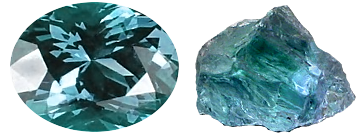 Photo of Kornerupine in Processed & Rough Form
Photo of Kornerupine in Processed & Rough Form
Kornerupine is a mineral with a hardness of 7 out of 10 on the Mohs scale of mineral hardness [?]. These Orthorhombicly structured gems are made of magnesium aluminum borosilicate, their full chemical compound being Mg4(Al,Fe)6(Si,B)4O21(OH).
Kornerupine is a rare magnesium aluminum borate silicate which occurs as transparent prismatic crystals of the orthorhombic system.
It is hard and a has good cleavage in one direction. Colours include a characteristic dark green leaning to brown and a rare and attractive bright vanadium green. This pleochroic colours are brown to greenish brown. Chatoyant stones show a bright eye against a dark green background. Vanadium-coloured stones are a very attractive bright apple-green and are rare.
Its pleochroism is visible to the naked eye. It exhibits different colors depending on what angle it is viewed.
Kornerupine occurs in boron-rich volcanic and sedimentary rocks subjected to metamorphism.
From Greenland the samples are dark green, light blue, reddish blue. From Sri Lanka and Malagasy: brownish green, yellowish brown. From Kenya and Tanzania: bluish green, emerald green, reddish purple, reddish blue, greenish yellow.
Most gem material is found in the Sri Lanka gem gravels in the Matale and Ratnapura districts and gem crystals (some a pale blue) also occur at Itrongahy, Betroka, Madagascar. The Myanmar gem gravels have produced greenish brown specimens. The vanadium-green specimens appear to come only (so far) from the Kwale area of Kenya; some may show a yellow fluorescence.
Gemstone quality specimens come from Greenland, Kenya, Tanzania, Sri Lanka, Myanmar, Malagasy, and Canada.
Cats-eye kornerupine is a dark, greenish to yellowish variety of kornerupine from Sri Lanka that exhibits a small deeply colored flacks and very sharp chatoyancy.
Kornerupine is sometimes confused with enstatite and tourmaline.
The specific gravity [?] for Kornerupine is 3.32, it's refractive index [?] is 1.66-1.68, and it's double refraction [?] is 0.013.
History
Kornerupine is named after the explorer, Andreas Nikolaus Kornerup, after it was first discovered in Greenland.
Industrial Usages
Kornerupine is a rare valued gemstone. It occasionally shows chatoyancy or asterism and is strongly dichroic, green to yellow to reddish brown. It is cut cabochon or faceted, rarely for the general market, but prized by collectors. Star kornerupine are found in Myanmar and cats-eye kornerupine are found in Sri Lanka. Kornerupine from Saxony, Germany is unnecessarily named prismatine.








